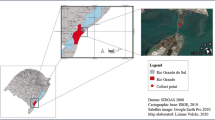Abstract
Weathered crude oil (WCO) removals in shoreline sediment samples were monitored for 60 days in bioremediation experimentation. Experimental modeling was carried out using statistical design of experiments. At optimum conditions maximum of 83.13, 78.06 and 69.92% WCO removals were observed for 2, 16 and 30 g/kg initial oil concentrations, respectively. Significant variations in the crude oil degradation pattern were observed with respect to oil, nutrient and microorganism contents. Crude oil bioremediation were successfully described by a first-order kinetic model. The study indicated that the rate of hydrocarbon biodegradation increased with decrease of crude oil concentrations.


Similar content being viewed by others
References
APHA (2005) Standard methods for the examination of water and wastewater, 21st edn. American Public Health Association, Washington, DC
Diaz E (2004) Bacterial degradation of aromatic pollutants: a paradigm of metabolic versatility. Int Microbiol 7:1139–6709
Huang L, Mab T, Li D, Liang F, Liu R, Li G (2008) Optimization of nutrient component for diesel oil degradation by Rhodococcus erythropolis. Mar Pollut Bull 56:1714–1718
Kim S, Choi D, Sim D, Oh Y (2005) Evaluation of bioremediation effectiveness on crude oil-contaminated sand. Chemosphere 59:845–852
Leahy JG, Colwell RR (1990) Microbial degradation of hydrocarbons in the environment. Microbiol Rev 54:305–315
Lepo JE, Cripe CR, Kavanaugh JL, Zhang S, Norton GP (2003) The effect of amount of crude oil on extent of its biodegradation in open water- and sandy beach-laboratory simulations. Environ Technol 24:1291–1302
Lin X, Li X, Sun T, Li P, Zhou Q, Sun L (2009) Changes in microbial populations and enzyme activities during the bioremediation of oil-contaminated soil. Bull Environ Contam Toxicol 83:542–547
Liu L, Hao RX, Chen SY, Guo HC (2004) An integrated feasibility study on designing remediation systems for petroleum contaminated sites. Water Air Soil Pollut 156:83–95
Mills MA, Bonner JS, Page CA, Autenrieth RL (2004) Evaluation of bioremediation strategies of a controlled oil release in a wetland. Mar Pollut Bull 49:425–435
Mohajeri L, Aziz HA, Isa MH, Zahed MA (2010) A statistical experiment design approach for optimizing biodegradation of weathered crude oil in coastal sediments. Bioresour Technol 101:893–900
Montgomery DC (2008) Design and analysis of experiments, 7th edn. Wiley, New York
Mrayyana B, Battikhi MN (2005) Biodegradation of total organic carbons (TOC) in Jordanian petroleum sludge. J Hazard Mater 120:127–134
Roncevic S, Dalmacija B, Ivancev-Tumbas I, Trickovic J, Petrovic O, Klasnja M, Agbaba J (2005) Kinetics of degradation of hydrocarbons in the contaminated soil layer. Arch Environ Contam Toxicol 49:27–36
US-EPA (1991) Test methods for evaluating solid waste—SW 846. United States Environmental Protection Agency, Cincinnati
US-EPA (1999) Method 1664, revision A: N-hexane extractable material (hem; oil and grease) and silica gel treated N-hexane extractable material (SGT-HEM; non-polar material) by extraction and gravimetry. United States Environmental Protection Agency, Cincinnati
Venosa AD, Holder EL (2007) Biodegradability of dispersed crude oil at two different temperatures. Mar Pollut Bull 54:545–553
Vieira PA, Vieira RB, Faria S, Ribeiro EJ, Cardoso VL (2009) Biodegradation of diesel oil and gasoline contaminated effluent employing intermittent aeration. J Hazard Mater 168:1366–1372
Zahed MA, Nabi Bidhendi G, Pardakhti A, Esmaili-Sari A, Mohajeri S (2009) Determination of polychlorinated biphenyl congeners in water and sediment in North West Persian Gulf, Iran. Bull Environ Contam Toxicol 83:899–902
Zahed MA, Aziz HA, Isa MH, Mohajeri L (2010a) Effect of initial oil concentration and dispersant on crude oil biodegradation in contaminated seawater. Bull Environ Contam Toxicol 84:438–442
Zahed MA, Aziz HA, Isa MH, Mohajeri L (2010b) Enhancement biodegradation of n-alkanes from crude oil contaminated seawater. Int J Environmental Research (in press)
Zhu X, Venosa AD, Suidan MT, Lee K (2001) Guidelines for the bioremediation of marine shorelines and freshwaters. United States Environmental Protection Agency, Cincinnati
Author information
Authors and Affiliations
Corresponding author
Rights and permissions
About this article
Cite this article
Mohajeri, L., Aziz, H.A., Isa, M.H. et al. Ex-situ Bioremediation of Crude Oil in Soil, a Comparative Kinetic Analysis. Bull Environ Contam Toxicol 85, 54–58 (2010). https://doi.org/10.1007/s00128-010-0058-1
Received:
Accepted:
Published:
Issue Date:
DOI: https://doi.org/10.1007/s00128-010-0058-1



